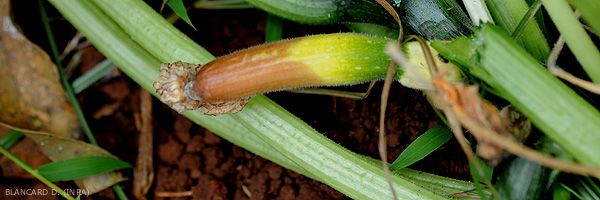
Fruit drips
This non-parasitic disease is linked to poor fertilization of the fruits of Cucurbitaceae, the flower life of which is sometimes very short. Indeed, in zucchini (figure 1), melon, watermelon and monoecious varieties of cucumber and other cucurbits, the female flowers must be pollinated quickly in order to develop into fruit.
If this is not the case, the fruit "blanks" will turn yellow and necrode (Figure 2).
This symptom should not be confused with that associated with apical necrosis . Let us add that fruit set defects can also manifest themselves in other forms: falling flowers, and deformation of the fruit: club-shaped, with apparent placenta (figures 3 and 4), and / or twisted (figure). 5)
Finally, during humid periods, zucchini flowers tend to stick to the young fruits, which increases the risks of their colonization by various opportunistic fungi that appreciate these nutrient bases, such as Botrytis cinerea , Rhizopus stolonifer , Choanephora cucurbitarum in tropical areas.
Several causes can explain fruit sagging:
- the absence or insufficiency of pollen linked to a limited number of male flowers. Indeed, their number varies during the production cycle (while it is practically zero at the very beginning of flowering), and according to the varieties.
- the weather conditions are not conducive to the activity of pollinating insects (temperatures too low, high humidity, lack of light, overcast and rainy, strong wind ...).
In addition, plants too loaded with fruit, whose root system is more or less damaged, may show more fruit drips.
In order to limit as much as possible the expression of coulure in Cucurbitaceae cultures, we can recommend:
- ventilate the shelters well in order to reduce the humidity which sometimes reduces the germination capacity of pollen grains;
- of not to whiten the plastic shelter in order to ensure a relatively good brightness;
- protect crops from the wind with hedges, or produce under cover;
- to ensure, if necessary, parthenocarpic development of the fruits by spraying growth substances. The fruits then develop in the absence of fertilization. For example, the courgettes thus obtained will often be sharp, not or poorly marketable. Parthenocarpic varieties are now available;
- eliminate aborted fruits in order to prevent Botrytis cinerea or the other two previously reported fungi from settling there secondarily. Subsequently, rotten fruits covered with gray mold or others may represent significant sources of inoculum.
* The coulure is characterized by the non-fertilization of the flowers (which subsequently drop) or by an extremely early arrest of the development of the young fruits (which subsequently shrivel).





